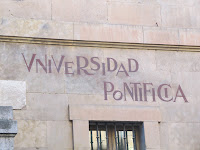 |
| The towers of Universidad Pontificia from inside Casa de las Conchas |
On the Rua Antigua in Salamanca there are two ancient edifices that face each other at uncomfortably close angles. These buildings are known to all of Salamanca as the Casa de las Conchas and the Universidad Pontificia. The Casa de las Conchas is a solid garrison lavishly decorated with carved sea shells and extravagant flourishes, while the Universidad Pontificia is a towering cathedral and college with illustrious religious images sculpted into the lofty buttresses. Passersby pause in the shadow of the two buildings and tilt their heads in curious gestures, as they ponder why two buildings of such grandeur are built so close as to block the other’s unique architecture.
Legend has it that the Jesuits built the Universidad Pontificia first and the owners of Casa de las Conchas, in an attempt to keep up with the Spanish Joneses, built their seashell house at the doorstep of the magnanimous structure. When the Jesuits saw that the finished Casa de las Conchas blocked their illustrious façade they began to spread a rumor around town that each shell carved into the side of Casa de las Conchas contained a precious jewel. What proceeded were a series of vandalisms against the Casa de las Conchas, resulting in ugly pock marks where certain shells used to be.
Whether this legend proves to be true or false, it serves as a somewhat accurate representation of the relationship between Spain with the Catholic Church.
 Since Isabel and Ferdinand reconquered Spain “debajo del cruz” “under the banner of the cross” in 1492, Spain’s history has been forever entwined with that of the Catholic Church. At times, it seems that it is an insurmountable task to dissect a facet that is both a part of the culture and a part of the soul of Spain. At others, it is evident that their relationship is a part of the Spanish culture, but does not encompass the culture.
Since Isabel and Ferdinand reconquered Spain “debajo del cruz” “under the banner of the cross” in 1492, Spain’s history has been forever entwined with that of the Catholic Church. At times, it seems that it is an insurmountable task to dissect a facet that is both a part of the culture and a part of the soul of Spain. At others, it is evident that their relationship is a part of the Spanish culture, but does not encompass the culture.
Depending on the leadership of Spain, there have been times of both war and peace with the Catholic Church. The history between these two factions is too vast to recount; however, fundamentally, a comfortable alliance of give and take had remained the status quo until the 1930’s. Up until the Second Republics radical anticlericalism and Franco’s subsequent despotic adoption of the faith for Spain, the Church had remained an inherent component of the Spanish culture. However, after Franco’s abuse of power, it seems that Spain is wary of religious influence. In fact, the most recent Spanish constitution, written in 1987, emphasizes the separation of church and state in Spain.
 Nevertheless, no amount of wishing can take away the traditions and memories of a 500 year relationship. In fact, in less than a week, Madrid will host more than a million Catholic youth and the head of the Catholic Church, Pope Benedict XVI, for the 2011 World Youth Day. An infinite number of Spanish cathedrals are papered with banners promoting the event both inside and outside of Madrid. The presence of Spanish citizens protesting the Pope’s arrival only serves to reinforce the polemic relationship between religion and state.
Nevertheless, no amount of wishing can take away the traditions and memories of a 500 year relationship. In fact, in less than a week, Madrid will host more than a million Catholic youth and the head of the Catholic Church, Pope Benedict XVI, for the 2011 World Youth Day. An infinite number of Spanish cathedrals are papered with banners promoting the event both inside and outside of Madrid. The presence of Spanish citizens protesting the Pope’s arrival only serves to reinforce the polemic relationship between religion and state.
Like the infamous edifices of Casa de las Conchas and Universidad Pontificia, Spain and the Catholic Church share a relationship that is both celebrated and mourned. There is no moving these buildings, there is no changing history, there is only the fact that they must continue to live side by side, sharing each other’s history and tradition.
No comments:
Post a Comment